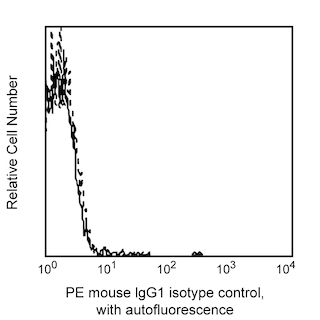Old Browser
Looks like you're visiting us from {countryName}.
Would you like to stay on the current country site or be switched to your country?


.png)

Flow cytometric analysis of CD125 expression on human peripheral blood eosinophils. Human eosinophils were stained with either PE Mouse Anti-Human CD125 (Cat. No. 555902; solid line histogram) or PE Mouse IgG1, κ Isotype Control (Cat. No. 555749; dashed line histogram). Fluorescent histograms were derived from gated events with the forward and side light-scattering characteristics of viable cells. Flow cytometry was carried out on BD FACScan™ system.
.png)

BD Pharmingen™ PE Mouse Anti-Human CD125
.png)
Regulatory Status Legend
Any use of products other than the permitted use without the express written authorization of Becton, Dickinson and Company is strictly prohibited.
Preparation And Storage
Product Notices
- Since applications vary, each investigator should titrate the reagent to obtain optimal results.
- An isotype control should be used at the same concentration as the antibody of interest.
- Caution: Sodium azide yields highly toxic hydrazoic acid under acidic conditions. Dilute azide compounds in running water before discarding to avoid accumulation of potentially explosive deposits in plumbing.
- For fluorochrome spectra and suitable instrument settings, please refer to our Multicolor Flow Cytometry web page at www.bdbiosciences.com/colors.
- Please refer to www.bdbiosciences.com/us/s/resources for technical protocols.
Companion Products


The A14 monoclonal antibody specifically recognizes the α chain of the Interleukin-5 Receptor (IL-5Rα), which is also known as CD125. IL-5Rα is a 55-60 kDa type I transmembrane glycoprotein that is expressed on B1 B cells, eosinophils, basophils and mast cells. The IL-5Rα chain associates with CD131 (Common β-chain) which serves as the signaling common β-chain subunit of the IL-5R complex as well as for the Interleukin-3 (IL-3R) and GM-CSF receptor (GM-CSFR) complexes. IL-5 promotes the growth and differentiation of eosinophil precursors and activates mature eosinophils. Clone A14 was developed using IL-5Rα-transfected cells as immunogen. This antibody binding can be blocked by IL-5.

Development References (2)
-
Blom M, Tool AT, Kok PT, Koenderman L, Roos D, Verhoeven AJ. Granulocyte-macrophage colony-stimulating factor, interleukin-3 (IL-3), and IL-5 greatly enhance the interaction of human eosinophils with opsonized particles by changing the affinity of complement receptor type 3. Blood. 1994; 83(10):2978-2984. (Biology). View Reference
-
Ingley E, Young IG. Characterization of a receptor for interleukin-5 on human eosinophils and the myeloid leukemia line HL-60. Blood. 1991; 78(2):339-344. (Biology). View Reference
Please refer to Support Documents for Quality Certificates
Global - Refer to manufacturer's instructions for use and related User Manuals and Technical data sheets before using this products as described
Comparisons, where applicable, are made against older BD Technology, manual methods or are general performance claims. Comparisons are not made against non-BD technologies, unless otherwise noted.
For Research Use Only. Not for use in diagnostic or therapeutic procedures.
Refer to manufacturer's instructions for use and related User Manuals and Technical Data Sheets before using this product as described.
Comparisons, where applicable, are made against older BD technology, manual methods or are general performance claims. Comparisons are not made against non-BD technologies, unless otherwise noted.
Report a Site Issue
This form is intended to help us improve our website experience. For other support, please visit our Contact Us page.